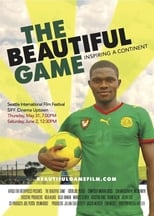Producer Julian Cautherly and Director Victor Buhler began working on their Africa10 film project in advance of WC 2010. Their lofty goal was to show how a passion for soccer encourages development and change in Africa.
But for those in poverty, soccer is more like a winning lottery ticket out of the country to a better life that they have no other means to achieve.
Most of The Beautiful Game covers two youth academies: the Right to Dream Academy in Ghana and the KFA Kwara Football Academy in Nigeria. Ema Boateng, a 14 year old Ghanaian academy product is held up as an example as he earns a scholarship to private boarding high school, Cate School in Carpinteria, CA. (Ema now plays for the LA Galaxy.)
The film also follows a player from Cameroon, Simo Faoleng Patrick, who is abandoned and stranded in Nigeria by a dishonest agent. This film only spends 6 minutes showing Patrick’s plight, and you would do better to watch Soccer’s Lost Boys to get the true insight into soccer player trafficking in Africa. The vast corruption in African soccer is mentioned only in passing.
There are two minor story lines: AFESCI, a womens supporters group that provides a calming presence at Ivory Coast MNT games, and a disabled youth team in the Kenyan MYSA (Mathare Youth Sports Association).
Sports should not be promoted as a way out of poverty
The problem with this movie is that it promotes the idea that sports is a reasonable way out of poverty. This is a myth that many have debunked in America for decades, starting with UC Berkeley Professor Harry Edwards. Speaking of African Americans in 1979, he said,
“Statistically, you have a better chance of getting hit by a meteorite in the next 10 years than getting work as an athlete.”
– UC Berkeley Professor Harry Edwards
The odds could be even worse for players in Africa, who have to find a way to Europe or the USA.
In some ways, this movie feels like an ad for the academies. While they offer a chance for a few hundred boys to get some schooling and get fed regularly, overall do they really help better Africa? The movie’s role model, Ema Boateng, was Gatorade player of the year for his CA high school, graduated in 3 years (hard to believe, given how far behind these kids have to start), attended UCSB for one year, and then left to play in Sweden. Despite his small stature of 5’6″, he is now playing in the MLS.
The question is, after his stint in the USA, if he returns to Ghana, what education and skills will he bring home? Will he be able to start a business? Or will he only be able to put more Ghanians through the academy system?
Update Apr-2017: It turns out that the small Cate and Dunn boarding schools, 50 miles apart on the California Central Coast, have advanced 3 Right to Dream players for MLS:
- Ema Boateng
- Joshua Yaro, #2 pick in 2016 MLS SuperDraft by Philadelphia Union
- Abu Danladi, #1 pick in 2017 MLS SuperDraft by Minnesota United FC
Update Sep-2018: In addition, according to Ed Hawkins, Dominic Oduro also came out of the Right to Dream Academy.
5 Soccer Movie Mom Rating = 5
Resources:
- Release Date: 2012-10-04 (UK)
- In English with some French and African languages
- IMDB
- Director: Victor Buhler
- Watch the Trailer

